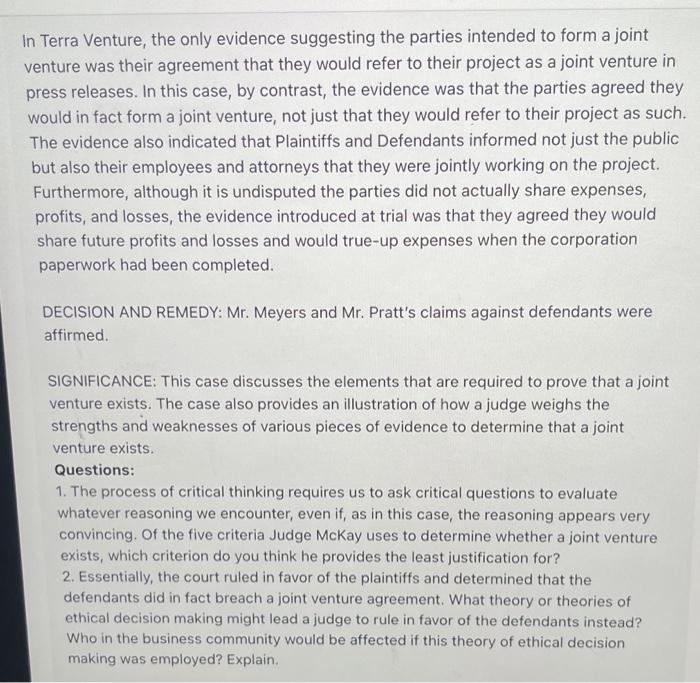se 2: MEYER v. CHRISTIE U.S. Court of Appeals for the Tenth Circuit CTS: In March 2005, David Christie and Alexander Glen met with Alan Meyer and John att and allegedly entered into an oral joint venture agreement to purchase and manage area for residential housing. The four agreed that they would call the joint venture unction City Partners, that Mr. Christie and Mr. Glen would be 50/50 partners with Mr. Aeyer and Mr. Pratt, and that they would hire a contractor from Dovetail Builders. However, a few weeks later, Mr. Christie and Mr. Glen terminated their relationship with Mr. Meyer and Mr. Pratt and formed a corporation, The Bluffs LLC. Christie and Glen then gave 50 percent partnership interest in the The Bluffs LLC to two outside individuals. At this time, plaintiffs Meyer and Pratt, joined by Dovetail Builders, filed a claim of breach of the joint venture agreement and claims of breach of fiduciary duty and wrongful dissociation against the defendants, Christie and Glen. The jury found in favor of the plaintiffs on all of these claims and found more than $9 million in damages. The defendants appealed, asserting the lack of existence and enforceability of the alleged joint venture agreement. ISSUE: Did the defendants breach the joint venture agreement by terminating their contract with the plaintiffs? REASONING: The defendants argue that a joint venture does not exist because the fourth factor of the following five have not fully been met, and a party must prove these factors to prove that a joint venture exists according to Terra Venture, Inc. V. JDN RealEstate Overland Park, L.P. The five factors for determining whether a joint venture exists are: (1) the joint ownership and control of property; (2) the sharing of expenses, profits, and losses and having and exercising some voice in determining the division of net earnings; (3) a community of control over and active participation in the management and direction of the business enterprise; (4) the intention of the parties, express or implied; and (5) the fixing of salaries by joint agreement. The court was not persuaded by the defendants' argument. The court reasoned that the evidence presented in this case to prove that a joint venture existed was much stronger than the evidence avallable in Terra Venture: n Terra Venture, the only evidence suggesting the parties intended to form a joint /enture was their agreement that they would refer to their project as a joint venture in press releases. In this case, by contrast, the evidence was that the parties agreed they would in fact form a joint venture, not just that they would refer to their project as such. The evidence also indicated that Plaintiffs and Defendants informed not just the public but also their employees and attorneys that they were jointly working on the project. Furthermore, although it is undisputed the parties did not actually share expenses, profits, and losses, the evidence introduced at trial was that they agreed they would share future profits and losses and would true-up expenses when the corporation paperwork had been completed. DECISION AND REMEDY: Mr. Meyers and Mr. Pratt's claims against defendants were affirmed. SIGNIFICANCE: This case discusses the elements that are required to prove that a joint venture exists. The case also provides an illustration of how a judge weighs the strengths and weaknesses of various pieces of evidence to determine that a joint venture exists. Questions: 1. The process of critical thinking requires us to ask critical questions to evaluate whatever reasoning we encounter, even if, as in this case, the reasoning appears very convincing. Of the five criteria Judge McKay uses to determine whether a joint venture exists, which criterion do you think he provides the least justification for? 2. Essentially, the court ruled in favor of the plaintiffs and determined that the defendants did in fact breach a joint venture agreement. What theory or theories of ethical decision making might lead a judge to rule in favor of the defendants instead? Who in the business community would be affected if this theory of ethical decision making was employed? Explain








